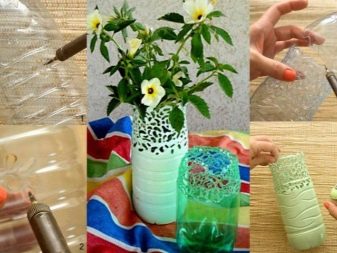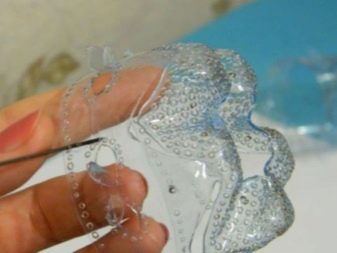How to make vases from plastic bottles with your own hands?

Now everything original is in vogue, including vases. If you do not want to receive a stamped item from mass production, you should contact the craftsmen who will accept your order and take into account all your wishes. If there is no suitable artist or you do not want to spend money, try making a vase with your own hands. To do this, it is not necessary to go to master classes or circles - it is enough to read the step-by-step instructions and be in the mood for success.
Peculiarities
A vase made from a plastic bottle has a lot of advantages.
- Availability. All kinds of bottles remain after food and household liquids that are constantly running out. And if suddenly you need to urgently deliver flowers, you can take any of the available ones or pour the leftovers into another container.
- Low cost. The cost price of such a product mainly depends on how you will decorate it. It only takes time to create the simplest uncoated option. More complex options will help out if there is a need to decorate the room temporarily, for example, when moving to a dacha, rented apartment, etc.
- An opportunity to show your talents. Even creating a small vase requires patience and some labor skills. In addition, in the process of creativity, completely unusual abilities can manifest themselves. In any case, a hand-made thing is a reason for pride.
- Ease of processing. Plastic is easier to work with than harder and thicker materials. Even a child can do a simple craft. Naturally, care must be taken when handling cutting tools.
- Environmental friendliness. By recycling materials, you contribute to the reduction of landfills.




Among the shortcomings, many note that homemade items look too simple and rude. Yes, if you just fill a bottle with water, it will look primitive. It all depends on your desire and skill. Even if something does not work out, there is an opportunity to do better next time by turning a random craft into a hobby.
What materials will you need?
The most affordable are plastic bottles. They are usually made from two types of plastics.
- PET - they sell drinks, sauces, oil. As a rule, the walls of such containers are rather thin, easily wrinkled. The content can easily outweigh them, so they are more suitable for dried compositions, pencils and other small things.
- PE HD - polyethylene of higher strength, therefore dairy products, shampoos and other cosmetics, household chemicals are poured into it. Such a container will be more stable. You can safely pour water into it and put flowers.
Almost every type of plastic that we can find in grocery stores cannot be reused in food due to the emissions of harmful substances. In everyday life, they can be used under certain conditions: they cannot be heated and exposed to direct sunlight. If you want to make sure that the material is safe, pay attention to the markings on the bottom.

Before choosing a blank for a future vase, you need to understand how you will use it. Depending on this, it can be:
- high or low;
- round, square or oval;
- smooth or threaded;
- with straight or curved walls;
- transparent or colored.

Think about where it will be located. Floor models are larger, while a dining table vase should be as low as possible. After you decide - rinse the bottle thoroughly, remove the label and the adhesive layer under it, dry well.
How to do it?
In fact, before choosing one of the options, stocking up on materials and tools, you need to soberly assess your own strengths. This does not mean that if you have never done anything with your own hands or have already had a sad experience, you should not even start. No and no again! In this case, it is necessary to start with a model that does not require a lot of effort and time, so that there is no temptation to drop everything halfway. Start with the simple and move to the more complex, then you will be proud not only of the result, but also of the knowledge, experience, and skills gained in the process of creation.


Painted vase
For its manufacture several steps must be followed in sequence.
- Measure the required height. Use a knife to remove the top.
- Sand down any unevenness on top with fine sandpaper. For security, tape the top edge with tape or colored adhesive tape.
- You can start staining. To do this, take measures so that paint does not come into contact with the surroundings, hands or clothing. Give preference to aerosols: they are applied more evenly than with a brush. If the bottle is very smooth, apply a primer first, wait until it dries and start painting.
- If patterns or drawings are supposed to be on the vase, wait until it dries completely.


Despite the seeming simplicity, it is important to take into account several nuances here.
- In order for the paint to lay down evenly and not to peel off ahead of time, thoroughly clean and dry the prepared dishes.
- White or clear bottles are ideal for staining. The brighter their color, the more coats of paint you may need. In addition, the layers of paint affect the intensity of the color.
- For stability, any material can be placed on the bottom, which, when solidified, will not dissolve with water, as well as pebbles, decorative balls, etc.

On a stand
In this case, both the top and the bottom are used.
- Separate the bottom up to five centimeters high.
- Cut a hole in the bottom equal to the diameter of the neck of the bottle. Remove irregularities.
- Insert the neck (without cap) into the hole. Thus, you will get a kind of flowerpot on a leg with a stand.


For stability, instead of support, you can take a piece of plastic or wood and give it any shape. The width of such a stand should not be less than the diameter of the bottle. It is also possible to increase the height of the leg with a suitable tube. You can connect the component parts with glue.
Wall
With it, you can revive the wall, turning the room into a blooming garden. You can use ropes for this.
- Cut off the top of the workpiece.
- Make two or four marks 1 cm from the edge, opposite each other.
- Heat a nail, awl, or screwdriver over the fire and pierce in the marked places.
- Now it remains to thread the ropes or laces and hang it on the wall. To prevent them from falling out, tie knots at the ends.




You can do without laces. For example, a nail in a wall can be threaded directly into the hole itself, then it will not be visible.



For this type of placement, it is more convenient to use square or oval bottles. Depending on the decoration method, the holes are made before or after. Also, the necessary parts of the bottles can be glued to the wooden base and already attached to the wall.
Openwork or carved
Sometimes, in order for the view to radically change, you can only decorate the edge. Even a schoolboy can cope with this task. In fact, the top line can not only be flat - depending on your imagination, it can easily become asymmetrical, wavy or jagged. To make it look beautiful and not have to redo or trim anything, apply the markings in advance and cut along it.For this, you can use both scissors and a stationery knife.



In this case, a fringe can become a more complex design method, and it can be bent both inward and outward. This can be done with all the elements, or you can do it through one, or lay them on top of each other in the form of weaving.

If there are only dry compositions in the vase, then all kinds of slots and holes can be made along its entire length. They can be repeated to form a lace pattern. To make them, the pattern can be applied directly to the plastic. You can also print the drawing on paper, fix it in several places and cut through it. This will significantly reduce the time, but you need to constantly monitor that it does not move.
Knives, a soldering iron, or heated metal tools with matching tips can be used to create patterns. The choice of tools depends on your skill level and dexterity.


Interesting examples
The above options, of course, are not the only ones, but you can take them as a basis, change the technology and get completely new ones. For example, on top of a plain layer, you can walk with a sponge or brush with paint in a contrasting color. The resulting effect looks voluminous and bright.

To hide the polyethylene base, it can be pasted over with threads, fabric, lace, ribbons, rhinestones or any other decorative material at hand. Decoupage is also one of the most popular techniques. It is important that the decor matches each other. In order not to overdo it - use no more than two materials, colors or textures. And then your vase will become a worthy exhibit in your apartment.


You can complicate the product by applying convex parts to a smooth surface. It can be all the same pieces of rope and fabric, glued and subsequently painted, as well as large rhinestones, stones, shells. To keep the stucco elements on the surface, it must be processed. Lightweight plastic parts are much easier to work with. And the same flowers for decoration can be made from the remaining parts, so do not rush to throw them away.

By the way, it is not always worth hiding the color and appearance in which the bottle was originally. Transparent plastic, which has fallen into skillful hands, will compete with glass. Such material is easy to process and does not require any costs, except time. And the result can be very decent.

If you've already made one vase and can't stop, consider creating a kit. Such an ensemble can be placed together or at some distance - in any case, their consistency and beauty will be visible. With this technique, you can easily change the interior at no cost.


For information on how to make a vase from plastic bottles with your own hands, see the next video.













The comment was sent successfully.